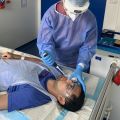New data shows prevalence of Premenstrual Dysphoric Disorder (PMDD)
29 January 2024
Around 1.6% of women and girls have symptomatic Premenstrual Dysphoric Disorder (PMDD), according to a new review of global studies.
Researchers led by Dr Thomas Reilly at the University of Oxford looked at studies from across the world to work out how many women and girls met the strict diagnostic criteria for the condition. The data suggested around 1.6% did – equivalent to around 31 million women and girls globally (1).
A higher proportion - 3.2% - had provisional diagnoses, where the condition is suspected but symptoms had not been measured for a sustained period of time to meet criteria for confirmed diagnosis.
The findings have been published in the Journal of Affective Disorders.
Symptoms of PMDD include mood changes (such as depression and anxiety), physical symptoms (such as breast tenderness, and joint pain), and cognitive problems (difficulty concentrating or memory complaints).
Dr Reilly, who is a Medical Research Council (MRC) Clinical Research Training Fellow in the Department of Psychiatry at Oxford University and Specialist Registrar at the National Female Hormone Clinic, Maudsley Hospital, says the proportion of those affected could be higher than 1.6%.
“Because diagnostic criteria is so strict, this is likely an underestimation of the lifetime prevalence of PMDD, and many more women and girls may be undiagnosed. Even so, the data emphasises that at a given timepoint there is still a significant minority of women with symptomatic PMDD, which is strongly associated with suicidal thoughts,” he said.
“There is little training around PMDD for psychiatrists or indeed medical students. Patients often find themselves falling through gaps in clinical services, such as between gynaecology and mental health services. GPs’ knowledge about PMDD is also very variable. In psychiatry, we rarely consider whether a patient’s symptoms might relate to hormonal changes.
“We need better awareness and training among health professionals about this debilitating but highly treatable condition so that patients can benefit from effective, evidence-based management and support,” Dr Reilly added.
Researchers used data from 50,659 female participants in 44 studies across six continents. They say the data challenges many preconceptions about the illness, including that it is a medicalisation of ‘normal’ menstrual symptoms, or that it was a ‘Western culture-bound syndrome’.
Clare Knox, an organisational psychologist who co-authored the paper and has experienced PMDD herself, said: “In a world where the health and wellbeing of every individual matters, the revelation that approximately 31 million females worldwide may be silently grappling with Premenstrual Dysphoric Disorder, a condition that deeply impacts their daily lives, cannot be overlooked.
“This staggering figure is a wake-up call, underscoring the urgent need for enhanced diagnostic processes, effective treatment plans, and robust support systems for those affected. More than ever, it is vital that we invest in comprehensive research and public health strategies to address and manage PMDD, ensuring that these millions of women do not face their struggles in the shadows, but rather with the full support and understanding of a society that values their health as a priority.”
Notes to editor:
1. Based on data from the United Nations Population Division for population of women and girls aged between 15-49 in 2021. Available here: World Population Prospects - Population Division - United Nations
Lisa Jones, Communications Manager, Department of Psychiatry
Tel: +44 (0)1865 618206 or email: [email protected]
- This new paper ‘The prevalence of premenstrual dysphoric disorder: systematic review and meta-analysis’ is in the Journal of Affective Disorders, available here: The prevalence of premenstrual dysphoric disorder: Systematic review and meta-analysis - ScienceDirect
- The University Department of Psychiatry’s mission is to conduct world-class research, teach psychiatry to medical students, develop future researchers in a graduate programme, teach doctors in training, promote excellence in clinical practice, and develop and provide innovative clinical services. It supports research in four key areas: neurobiology, psychological treatments, developmental psychiatry and social psychiatry. The Department is committed to the translation of scientific discovery into benefits for patients. www.psych.ox.ac.uk
- Oxford University has been placed number 1 in the Times Higher Education World University Rankings for the eighth year running, and number 2 in the QS World Rankings 2022. At the heart of this success are the twin-pillars of our ground-breaking research and innovation and our distinctive educational offer.
- Oxford is world-famous for research and teaching excellence and home to some of the most talented people from across the globe. Our work helps the lives of millions, solving real-world problems through a huge network of partnerships and collaborations. The breadth and interdisciplinary nature of our research alongside our personalised approach to teaching sparks imaginative and inventive insights and solutions.
- Through its research commercialisation arm, Oxford University Innovation, Oxford is the highest university patent filer in the UK and is ranked first in the UK for university spinouts, having created more than 200 new companies since 1988. Over a third of these companies have been created in the past three years. The university is a catalyst for prosperity in Oxfordshire and the United Kingdom, contributing £15.7 billion to the UK economy in 2018/19, and supports more than 28,000 full time jobs.
 Dr Ashwin Jainarayanan selected for 2024 Schmidt Science Fellow program
Dr Ashwin Jainarayanan selected for 2024 Schmidt Science Fellow program
 New study to improve vaccines and therapeutics development
New study to improve vaccines and therapeutics development
 Nature degradation could cause a 12% loss to UK GDP
Nature degradation could cause a 12% loss to UK GDP
 Alok Sharma to join the Oxford Martin School as a Visiting Fellow
Alok Sharma to join the Oxford Martin School as a Visiting Fellow
 Landmark study definitively shows that conservation actions are effective at halting and reversing biodiversity loss
Landmark study definitively shows that conservation actions are effective at halting and reversing biodiversity loss